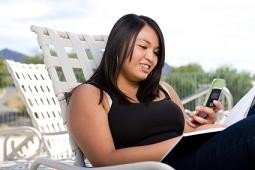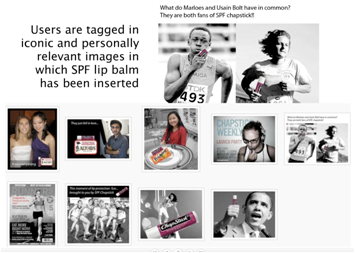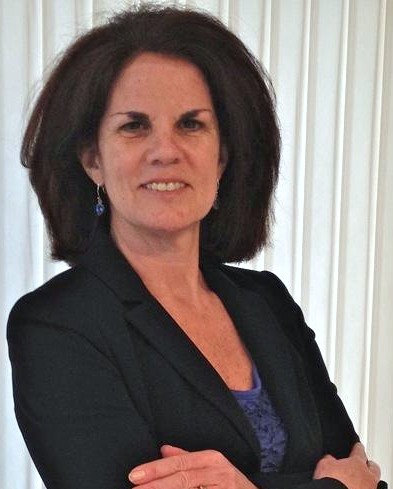UnitedHealth Group Launches OptumizeMe Mobile App to Motivate Healthy Behaviors
 November 10, 2010
November 10, 2010 During my panel at the World Congress mHealth Summit in July, Bud Flagstad, VP Strategic Initiatives at UnitedHealth Group mentioned their upcoming mobile app which is designed for healthy challenges.
OptumHealth, a business unit of UnitedHealth Group, has just launched the free OptumizeMe app for Windows Phone 7 devices, which will be followed by Android and iPhone platforms in 2011. OptumizeMe is a unique health and fitness app designed to make health both fun and social.
The idea of challenges and trackers was tested with UnitedHealth employees last summer. UnitedHealth found that the challenge participants tended to meet and exceed their fitness goals faster.
With OptumizeMe, you can create challenges and invite others in your social circle to participate. If you are planning a run challenge in Central Park, you can extend your invitation to others in the geography who then opt in to join you. You can use a map to show the location of your event and to check out other events in the area. You can also send motivational messages to your friends and family around the challenge and post your progress to Facebook. Others can respond with a “thumbs up” or a “butt kick” to move you closer to your fitness goal.
Once you complete your first Challenge, you receive your first virtual trophy, a Pioneer badge. Some badges are won based on your efforts and others are a surprise which keeps fitness fun.
In addition to social challenges, you can use OptumizeMe to manage your personal challenges such as training for a marathon or accelerating your physical activity during the holidays. Think about how you would use the OptumizeMe app. What personal challenges and social challenges would you choose to manage?
Purple Path for Consumer eHealth Engagement
 October 26, 2010
October 26, 2010

During the Partners’ Center for Connected Health conference, BJ Fogg, Director Persuasive Technology Lab Stanford University created quite a stir when kicking off the event. I heard many attendees continue to discuss his behavior framework throughout the conference. BJ clearly delineates between consumer behaviors that are new (green), familiar (blue) and continuous (purple). He defines the time frame for changing these behaviors as one time, spanning a time period or becoming an ongoing path.
Where Are You Asking Consumers to Go?
BJ emphasized the need to “put hot triggers in the path of motivated people”. Eric Zimmerman, CMO of RedBrick Health echoed BJ’s approach suggesting that “we figure out what people want to do and link their action path to that”. Eric also mentioned that it is easier for consumers to be healthier with others. He cited their recent research revealing that those “working alone to reach health goals were half as effective as those working as part of a team”.
During her keynote, Sheena Iyengar, Columbia Business School Professor and author of “The Art of Choosing” described the challenges that consumers have in selecting between their many options and how it becomes easier after gaining “expertise in the decision domain”. Sheena pointed to the strategy of providing guidance including social communities to generate the wisdom of the crowd around how they made their decision.
How Are You Designing Their Journey?
Several speakers warned against designing the path for them and highly recommended going through the process with them. Noam Ziv, VP Technology at Qualcomm explained that people have different approaches to their health and need options. Through research, companies can define the set of approaches and identify the profile of people that will respond to each.
How about those who have stopped along their way? Madeline Pantalone, VP of Strategy and Business Development at GreatCall (Jitterbug) described how they proactively reached out to those who stopped using their service to better understand their needs and resolve problems.
Consumers are forced to slow down when they encounter a disjointed experience. When asked about his wish list to motivate engagement, Scott Eising, Director Advance Market Product Development at Mayo Clinic described the opportunity to “bring together products and services by role into a unified experience”. Imagine the experience that can be designed for a patient with a chronic condition who is also a caregiver for her elder parent and the family custodian for health.
Where Do You Go From Here?
The “Futurists” panel was very thought provoking. Ron Zeiger, Chief Health Strategist at Google focused in on two groups of consumers. One group, “Quantified Self” measures everything and asks questions. The second group is a heavy user of search where they look for answers.
Eric Horvitz, Scientist at Microsoft Research explained that data collection is happening all around us, algorithms are being developed and interventions are being planned using “evidence based methods”.
I left the conference thinking about the situation described by the third panelist, Paul Maglio, Manager of Smarter Planet Service Systems at IBM Research. We are living longer and less healthy lives. “We need to do something beyond the data. Develop models and simulations for what may not have happened before and determine how that can play out in different scenarios.”
The future is emerging every day which makes the healthcare industry terribly exciting. I work with companies to understand their consumers’ evolving needs and conceptualize products that touch new channels, deliver new content and enable new capabilities for collaboration and community.
Together, we can define the purple path for consumer eHealth engagement.
Ready for the Silver Tsunami?
 September 29, 2010
September 29, 2010  Last week, I attended Mass Technology Leadership Council’s event on the Emerging Technologies for the Silver Tsunami: Aging in Place through the use of Integrated Technology. The room was packed with interested stakeholders from HIT technology companies, hospitals, home health agencies and senior living communities.
Last week, I attended Mass Technology Leadership Council’s event on the Emerging Technologies for the Silver Tsunami: Aging in Place through the use of Integrated Technology. The room was packed with interested stakeholders from HIT technology companies, hospitals, home health agencies and senior living communities.
This is one of several events across the country focused on opportunities that will be brought in with the new waves of seniors.
Beginning in 2011, the oldest of the 78 million baby boomers will turn 65 years old. According to the Stanford Center on Longevity, the "number of older people (age 65 and over) will double over the next 30 years, from 40 million to 80 million, and the percentage of older people in the population will increase from 13% to 20%".
Given the size of this new segment of seniors, their education, affluence and comfort with technology, they will have a powerful impact on healthcare delivery, health plans and aging services.
Riding the Waves:
Leveraging my extensive consulting experience and knowledge about elder care technologies, I have defined five requirements for HIT solutions to meet the needs of seniors, families, caregivers and the care team.
1. Extending Solutions for Care Management
“I want my mom’s doctor to know what is really happening when she is away from his office”.
Through acquisition and partnerships, companies are combining their “point solutions” to bring new capabilities to seniors and their care circle. HIT suppliers are also proactively seeking ways to tie their solutions into the EMR and Health Information Exchange to bring needed insight to the clinician and support the medical home care team.
2. Expanding Solutions across the Care Continuum
“I do not want to have to purchase, learn and manage all different technologies as my father ages.”
There is an opportunity for health information technology firms to design their solutions with a set of capabilities that can be turned on as the senior requires the support. Considering the burden of the adult children and caregivers, the solution for this market will meet the needs of seniors across the care continuum; preventative, acute, chronic and long-term.
3. Guiding Care Decisions
“We are all taking turns caring for my father and we are exhausted since his health is deteriorating each day.”
Most of us have access to calendars and communication technologies which we can use for personal reasons. The problem is that we do not know what to expect each day and find ourselves reacting instead of planning for the care of our loved one. When we have a few minutes, we call our friend who just went through this with her mom. Think about how social networking can be leveraged to help families anticipate, plan and make the best decisions with the guidance of experts and other experienced caregivers.
4. Supporting Service Delivery
“I need to know what our caregivers are observing and be alerted when mom needs additional care.”
Whether they are busy raising their own families or living in another state, adult children struggle to care for their elder loved ones. Professional caregivers including home health workers can use technology to record observations of daily living and engage in shared decision making with the family.
5. Supporting Self -Management
“My dad needs to be able to manage this diabetes on a daily basis”.
With the shortage of health care professionals, older consumers need to take care of their chronic conditions and understand how to make changes when they run into many different situations common to their condition. Technology can serve as an enabler by reminding the senior to take medications and perform certain behaviors, tracking these activities, educating them what to do when these activities are missed, monitoring their vitals and alerting caregivers when problems arise.
Getting Ready for the Silver Tsunami:
As you define/refine your own product strategy for the senior market, think carefully about the steps you will take. The senior market is made up of many different “sub-segments". It is important to identify and understand how these sub-segments differ in their needs, behaviors, technology usage and preferences. This research will provide the insight to guide your product development to meet the requirements of your target audience(s).
How can you prepare for the Silver Tsunami? Learn more.
Seven Mobile Health Engagers
 September 15, 2010
September 15, 2010  We see it every day and everywhere. Consumers are engaged with their mobile phones at restaurants, at the gym, by the pool, in parked cars and in the hallway outside of the doctor’s office. They have a strong need to stay connected and use every free moment to review and respond to messages as well as access online information through their mobile phones.
We see it every day and everywhere. Consumers are engaged with their mobile phones at restaurants, at the gym, by the pool, in parked cars and in the hallway outside of the doctor’s office. They have a strong need to stay connected and use every free moment to review and respond to messages as well as access online information through their mobile phones.
Over the past 6 months, I have heard health care providers, health plans, health care technology companies and employers express strong interest in reaching, engaging and influencing consumers through mobile health applications. Although mobile committees have been formed, most are in the beginning stages of identifying and prioritizing the applications that they will develop and deliver to consumers.
Seven Mobile Health Engagers:
Here are seven key capabilities that companies will want to build into their mobile health applications:
1. Guiding- Sending personalized alerts and reminders for motivating specific actions such as taking medications, testing blood sugar levels or participating in healthy behaviors (e.g. lunch time walk with co-workers).
Consumer perspective: What do I need to do to meet my health needs and goals?
2. Educating- Providing access to a customized set of health information, pushing informational tips based on needs, interests and profile and testing health information knowledge.
Consumer perspective: How can you make learning about my health fun, personalized and easy to understand?
3. Encouraging- Delivering support messages from my social network, clinician and health coach.
Consumer perspective: How can you support me in reaching my health goals at the right time?
4. Consulting- Enabling access to a live discussion with my clinician, health coach or mother’s caregiver.
Consumer perspective: How can you connect me with experts for real time communication and collaboration?
5. Monitoring- Capturing and viewing information about my mood, pain levels, symptoms, activity levels, diet and sleep.
Consumer perspective: How can you help me aggregate and organize all of my health information so that I can see patterns to experience “aha moments”?
6. Deciding- Accessing a decision support tool about my treatment options or viewing my PHR with links to relevant and "in context" content.
Consumer perspective: How can I make better decisions by combining my own information with trusted expert sources and accessing this wherever I am?
7. Managing- Delivering customized messages to help me effectively plan and respond to our health care needs.
Consumer perspective: How can I change from being reactive to becoming proactive about my health and the health of my family?
Generating Your Mobile Health Momentum…
How can you define and design these mobile applications to be most valuable to your target consumers? Unlike many of the mini-applications that consumers can buy in online stores, you have an opportunity to connect these capabilities such as “monitoring” and “deciding” so that consumers can not only track their activity but also make decisions with the patterns of data that emerge.
Think about how you can use “personalization” with your mobile health applications to motivate consumers to stay engaged in their health. How can you help consumers use their mobile phone to communicate and collaborate with their support network and caregivers for better health outcomes?
How far along are you with your mobile health strategies? Have you selected your priority consumer segments? Have you conducted research to deeply understand their needs, mobile behaviors and attitudes? Have you conceptualized, defined and validated a solution for each segment? Are you ready to pilot the solution with the target segment? Have you defined your measurements for success?
With experience and industry knowledge in the mobile health space, how I can help you move your mobile initiatives forward?
Read more about my mobile health technology expertise.
SPF Stalker & Healthy Check-ins; Social Media Interventions Designed By & For Students
 August 4, 2010
August 4, 2010

During my Healthcare Unbound Panel on “New Models in Social Media”, Kendra Markle from the Stanford Persuasive Technology Lab shared interesting examples of students designing their own social media interventions.
While co-creating with a consumer segment, you can design applications they value which leverage their relationships with their own social network and influence both personal and group behaviors.
Our Interview:
Sherri (Stepping Stone Partners): Tell me about how students define their own interventions. For example with SPF Stalker, what is the goal and how did students participate in this innovation process?
Kendra (Standford Persuasive Technology Lab):This project was created by some ingenious students as part of a class on habit formation taught by BJ Fogg, Director of the Stanford Persuasive Technology Lab. The project goal was to use technology to motivate people to wear sunscreen every day.
Students came up with this great idea to photoshop pictures of SFP chapstick into photos of famous people and photos they took of each other as a humorous way to remind each other about wearing SPF chapstick. By tagging their friends in the photos posted to Facebook, each friend gets an irresistible email from Facebook saying "you've been tagged! Click this link to see the photo". The response rates for click throughs on Facebook tagging emails is unbelievably high.
Sherri: What are the comments that students have shared about SPF Stalker? Why do they want to use it with their friends?
Kendra: This intervention was designed to be funny, which made the photos memorable enough to share with friends, thereby recruiting even more people into the intervention without them realizing it. We call this a stealth tactic - when people start engaging in healthier behavior without being explicitly told they're participating in a "health" app.
Sherri: What is the goal for the Healthy Check-ins project that you presented?
Kendra: The healthy check- ins project is also a stealth project, that's just our internal name for it. Our goal for the healthy check ins project is to combine the element of checking in with target health behaviors such as taking the stairs instead of the elevator, eating less meat or biking to work instead of driving. By checking in, many people feel some validation of their behavior, or feel they get credit for doing it by reporting it. We combined this urge with the fun of unrealistically awesome achievements from the game world to produce an experience that rewards you with virtual goods and powers that help you in the game world for indulging in the urge to check in your real behaviors. The motivation you feel to level up in the game layer can be translated into motivation to complete healthy behaviors just so that you can check them in.
Sherri: How do students feel the Healthy Check-ins will help them and their friends become more healthy (e.g. what is the value that students see?)
Kendra: So far, the students are excited about this project because it's something that they think they would use and could picture themselves getting a little addicted to. Since college aged kids want to do everything with their friends, we're working on making this intervention a social experience, one that requires use of both reciprocity and vengeance to advance. These are two behaviors that are believed to have evolved to encourage us to cooperate with each other. Cooperation is a very strong intrinsic motivator, as is competition, especially when both are used together.
Sherri: Since “location based services” (Foursquare like) are so popular, how have the students envisioned the connection between this capability and healthy locations for check-ins?
Kendra: We've expanded beyond location check ins to behavior check ins. Why is everyone feeling limited to location check ins? GPS technology provide convenient proof of presence at a location that can translate into monetary value but there are many other things that can be easily proved when using a mobile phone. It just takes some creativity. Students have come up with a whole bunch of target behaviors and creative ways to prove they're engaging in them, all while in stealth mode so the user never feels like they're supposed to be "getting healthy" while using the app.


